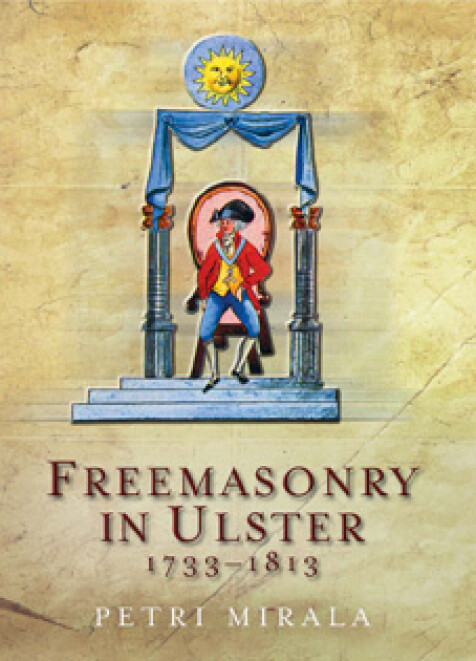Freemasonry in Ulster, 1733–1813
A social and political history of the masonic brotherhood in the north of Ireland
Petri Mirala
‘There is much to commend in Mirala’s social analysis … Mirala offers us an almost forensic analysis of the evolving, varying relationship between masonry and the Volunteers, United Irishmen, and Defenders on the one hand, and Orangeism on the other. In so doing, he usefully demolishes a series of myths: that freemasonry was, uniformly, an early 'vehicle' for democratic, radical or republican sentiment; that the United Irishmen attempted a concerted infiltration of Ulster Masonic lodges in 1794–5; and that the structures of Orangeism drew, seamlessly, from freemasonry as their organisational model … [H]e has done stalwart service in providing an intriguing regional perspective on an aspect of eighteenth-century Irish life that rightly deserves a more central place in the gaze of modern Scholarship’, Lindsay Proudfoot, Australasian Journal of Irish Studies.
'A superb study of the Irish Masonic movement … This book is worth every penny, putting Freemasonry into its proper social and political context in an Ireland whose divisions have lasted well into the 21st century', John Jackson, MQ Magazine.
'Freemasonry must be one of the most misunderstood and misrepresented phenomena in Irish history. As one of the few prominent public organisations that provided a space where Catholics and Protestants could meet as equals in the eighteenth century, it was to the benefit of Catholics, yet this did not secure it from the attention of the Church authorities, and it was singled out for condemnation by Archbishop Troy of Dublin in 1811 .... The greatest challenge that faced Dr Mirala when he undertook to research the story of freemasonry in eighteenth-century Ireland was to reconstruct a reliable organisational history. He was not assisted by the partial nature and difficult character of the evidential record, and he was prompted by this consideration to focus on Ulster. It was a wise decision, for though he draws on the history of the movement across Ireland to illuminate its main characteristics, its particular history in Ulster is sufficient to permit him to achieve his stated objectives. These are to locate Irish freemasonry in the context of ‘the wider European world of clubs and societies’, and to explore the ‘substantial links’ between masonry and politics that were manifest in the final decades of the eighteenth century. He does both well. His exploration of the social history of masonry makes a significant contribution to the study of associative culture in Ireland, while his forensic dissection of the nature of political masonry provides the most convincing analysis of its impact on loyalism and republicanism published to date .... a balanced history of a singularly misunderstood institution during the most influential and interesting phase in its history,' Dr James Kelly, Irish Economic and Social History (Winter 2008).
'Irish freemasonry has long suffered from a lack of sustained academic attention. While historians such as Nancy Curtin and Kevin Whelan have suggested that freemasonry was a shaping force in the popular political movements of the late eighteenth and early nineteenth centuries, the study of masonic history has largely been left to popular writers and the masons themselves. In Freemasonry in Ulster, 1733–1813, Petri Mirala begins the work of correcting this oversight by examining the development of freemasonry between the founding of the first masonic lodge in Ulster in 1733 and the movement’s decline in the early nineteenth century. Using masonic records in conjunction with government papers, contemporary publications, and other sources, he moves beyond modern assumptions about eighteenth-century masonry and reveals it to be an extensive and varied phenomenon with connections to a wider world of male sociability .... Mirala’s work sheds light upon an understudied aspect of eighteenth-century Irish history and gives freemasonry its due as an influential part of Irish society. As Mirala himself suggests, his book is a starting point in the study of Irish freemasonry; he has opened up an intriguing ground for future study', Mary Sanderson, Journal of British Studies.
‘Mirala’s book is a welcome addition to a growing academic interest in freemasonry as well as in the settings that permit religious toleration to flourish … The wealth of material we now have on Ulster, thanks to Mirala, shows us how late in the eighteenth century the transformation of social experience into political aspirations occurred. His book also rightly highlights the pitfalls of making generalizations about the political direction that Masonic fraternizing could or should take. It cautions us that local context was critically important and that lodges in rural County Down could be remarkably different from those in Armagh, a mere fifty miles away. To his great credit Mirala has put Irish freemasonry on the academic agenda and new work on the subject must begin with this book’, Margaret C. Jacob, American Historical Review (June 2008).
'[Mirala's] book serves a valuable function in demonstrating that the study of fraternities in a fascinating, important, and documentable strand in modern Irish social and political history. He has wrested a concealed but powerful historical force from the province of devotees, cranks, and conspiratorialists', David Fitzpatrick, Ulster Genealogical Review.
'Freemasonry in Ulster 1733–1813, a vital contribution not only to the history of freemasonry in Ireland, but also to broader work on associational culture. He fleshes out the organisation, showing its remarkably varied membership, and reasons for joining, in such a fashion that the reader cannot fail to agree with his conclusion that it is “simplistic to see masonry either as the ‘missing link’ between the Enlightenment and the United Irishmen, or as a slightly more respectable precursor of Orangeism”. Also to be welcomed is Mirala’s detailed work at the lodge level, which, again, allows him to produce a book that manages to get away from the generalisations that have encumbered past work on this topic', Martyn Powell, Eighteenth Century journal (2010).

